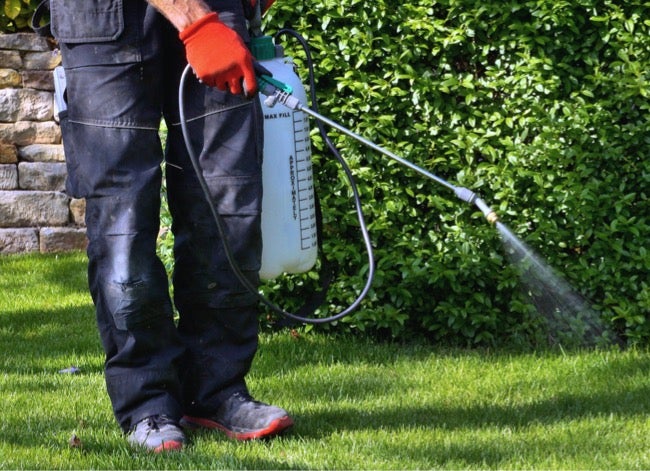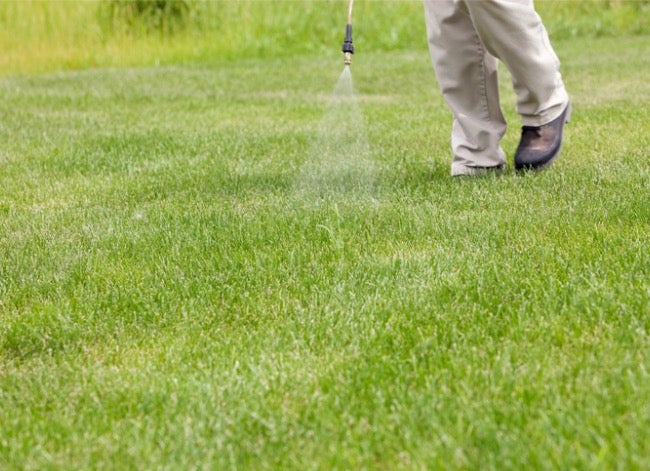Solved! When to Apply Pre-Emergent to Prevent a Weedy Lawn and Garden - BobVila.com
Stop weeds before they get a foothold by applying a pre-emergent herbicide at the right time.

istockphoto.com
Q: When should I apply pre-emergent weed control?
A: Knowing when to apply pre-emergent herbicide can mean the difference between having a lush, weed-free lawn or a yard riddled with dandelions and other unwanted plants.
Pre-emergent weed killers fit into a particular group of herbicides that don't kill unwanted plants. Instead, they stop the seeds of unwanted plants from sprouting in the first place. Various pre-emergent products are available for lawns, vegetable gardens, and flower beds. However, applying them too early can keep beneficial seeds from sprouting, and applying them too late won't do any good. Ahead, learn when to use pre-emergent and when not to.
Early spring and fall are the most effective times to apply pre-emergent herbicides.
Applying a pre-emergent herbicide will prevent seeds from sprouting, but the most effective times to use it are in the spring and again in the fall.
- Early spring application: By treating lawns and perennial flower beds in early spring, gardeners can drastically reduce the number of annual summer weeds such as crabgrass, foxtail, and sandbur, which germinate in late spring. However, this is not the time to treat the soil in a garden or annual flower bed where beneficial seeds, such as flowers, corn, cucumbers, or squash, will be sown. Pre-emergents don't keep just unwanted seeds from sprouting—they keep all seeds from germinating, so hold off on using the product in a garden or flower bed until the desired plants sprout and begin to grow.
- Fall application: A lawn might appear virtually weed-free going into fall but then weeds suddenly appear. The pre-emergent applied in spring is no longer protecting the yard by this time, and a few invasive weed seed varieties, such as henbit and chickweed, are lying in wait for cooler temps before sprouting. After sprouting, these hardy weeds will remain small, perhaps even unnoticeable, throughout the winter. Still, next year, they'll revive in spring and grow with a vengeance. By then, it's too late to use a pre-emergent—a post-emergent herbicide is necessary at that point.
RELATED: Watch Out for These 9 Types of Lawn Weeds

istockphoto.com

Apply spring pre-emergent when the soil temperature is around 55 degrees or above.
Rather than setting a specific date for applying a pre-emergent, a good rule of thumb is to use pre-emergent when spring soil temperatures are around 55 degrees for at least 48 hours. Directions don't always apply, because the climate varies from region to region. In southern USDA growing zones, such as Louisiana, this means around the first of March, while the temps will be more conducive to applying a pre-emergent in North Dakota when June arrives.
In the fall, it's also a good idea to apply a pre-emergent when the soil temp cools to around 55 degrees. This usually corresponds with daytime temperatures that range from the mid-60s to the mid-70s, indicating the soil is cooling to the temps at which cold weather seeds prepare to sprout.
Granules or liquid formulations are the two primary types of pre-emergent herbicides.
Both types of pre-emergent herbicides, liquid and granular, work in the same way to keep weed seeds from sprouting, and choosing one is often more about personal preference.
- Liquid: Easy to apply with a pump-type garden sprayer, liquid pre-emergent herbicides are available either in full-strength products or as concentrates that require diluting in water before using.
- Granular: Resembling tiny grains, granular pre-emergent products are applied using a drop spreader, a broadcast spreader, or even by shaking the granules onto the soil with a cup. Using a spreader works best for even coverage on large areas, such as lawns. Still, gardeners might prefer sprinkling the granules around established plants in a vegetable or flower garden using a cup, and then working the granules into the soil's surface.

istockphoto.com
RELATED: The Best Grass Seed Options for Your Lawn
Reseeding a lawn too soon after applying a pre-emergent herbicide may keep the grass seeds from sprouting.
A typical step in keeping a lawn lush involves reseeding in late spring or early summer to add more grass to the turf and create a denser yard. Unfortunately, overseeding while a pre-emergent herbicide is still effective will prevent the grass seeds from sprouting. When overseeding, wait a minimum of 8 weeks after applying a pre-emergent.
If waiting isn't an option because the grass species, such as fescue, needs cooler temps to sprout, consider skipping the fall application of pre-emergent and overseed the lawn at that time instead. This might result in needing to apply both a pre-emergent in early spring of the following year, followed by a post-emergent lawn herbicide a few weeks later to control both weed seeds and weeds that might have germinated over the winter.

istockphoto.com

Comments
Post a Comment